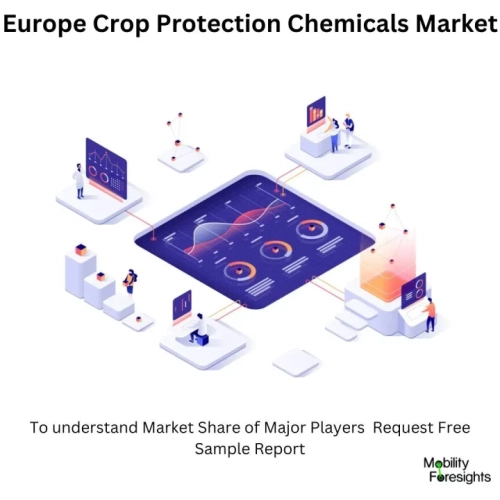
- Get in Touch with Us

Last Updated: Apr 25, 2025 | Study Period:
The Europe crop protection chemicals market is experiencing steady growth, driven primarily by the rising demand for efficient agricultural solutions amidst environmental challenges. Traditional chemical pesticides, such as herbicides, insecticides, and fungicides, remain key players, but bio-based solutions are quickly gaining ground. Technological advancements like AI-driven pest control systems, precision agriculture, and drone applications are enabling farmers to optimize chemical usage, reducing waste and increasing crop yields.
However, the market faces challenges in the form of stringent regulations aimed at reducing the use of synthetic chemicals. The European Unionâs aggressive policy push for sustainable agricultural practices, including the Farm to Fork Strategy, is a critical driver of market transformation. Companies are now forced to innovate and develop bio-based solutions that meet both consumer and regulatory demands.
The Europe crop protection chemicals market encompasses the various chemical products used to manage and control crop pests, weeds, and diseases. It plays a pivotal role in ensuring food security by boosting crop yields and safeguarding agricultural productivity against various threats. This market includes a range of chemicals such as herbicides, fungicides, and insecticides, all vital to modern farming operations.
There are several types of crop protection chemicals, primarily synthetic and bio-based solutions. Synthetic chemicals have dominated the market for decades, but bio-based alternatives, derived from natural substances, are gaining traction due to environmental concerns. These include bio-pesticides, bio-fungicides, and other eco-friendly solutions aimed at sustainable farming.

The primary applications of crop protection chemicals are in agriculture, horticulture, and forestry. These chemicals help in controlling pests, weeds, and plant diseases, thereby boosting crop quality and quantity. Additionally, they play a significant role in maintaining the health of crops in large-scale commercial farming.
While crop protection chemicals offer significant benefits like higher yields and pest resistance, they also come with challenges. Concerns over environmental impact, regulatory restrictions, and consumer demand for organic produce are forcing the industry to innovate. The challenge lies in balancing effectiveness with sustainability and safety.
The Europe crop protection chemicals market was valued at USD 12 billion in 2023 and is projected to reach approximately USD 17 billion by 2030. This growth is fueled by advancements in farming technologies and increasing investments in bio-based pesticides. The market is expected to grow at a compound annual growth rate (CAGR) of 4.5% during the forecast period. Rising demand for food security, coupled with the need to increase crop yield, continues to drive the market forward.
The European crop protection chemicals market is experiencing several key trends that are reshaping the landscape. One of the most prominent trends is the increasing adoption of bio-based crop protection chemicals, driven by the EUâs strict regulations on chemical pesticides. Another significant trend is the integration of precision agriculture tools, such as drones and sensors, enabling farmers to apply chemicals more effectively and efficiently. Moreover, the shift towards sustainable farming practices, supported by government policies, is influencing consumer behavior, with a growing preference for organic and eco-friendly solutions. Lastly, digital farming platforms offering real-time monitoring and data analysis are emerging as crucial tools for optimizing chemical use, improving both yield and sustainability.
By Type:
By Crop Type:
By Application:
By Geography:
| SI No. | Topic |
| 1 | Market Segmentation |
| 2 | Scope of the Report |
| 3 | Research Methodology |
| 4 | Executive Summary |
| 5 | Key Predictions of the Europe Crop Protection Chemicals Market |
| 6 | Average Pricing by Crop Protection Chemical Type |
| 7 | Major Drivers for the Europe Crop Protection Chemicals Market |
| 8 | Europe Crop Protection Chemicals Market Production Footprint – 2023 |
| 9 | Technological Developments in Crop Protection |
| 10 | New Product Development in Europe Crop Protection Chemicals Market |
| 11 | Research Focus Areas in Crop Protection Chemicals |
| 12 | Key Trends in the Europe Crop Protection Chemicals Market |
| 13 | Import and Export of Crop Protection Chemicals and Their Impact |
| 14 | Regulations and Standards in Crop Protection, by Region |
| 15 | Major Projects Utilizing Crop Protection Chemicals |
| 16 | Market Size, Dynamics, and Forecast, by Geography, 2024-2030 |
| 17 | Market Size, Dynamics, and Forecast, by Product Type, 2024-2030 |
| 18 | Market Size, Dynamics, and Forecast, by Crop Type, 2024-2030 |
| 19 | Market Size, Dynamics, and Forecast, by Application, 2024-2030 |
| 20 | Competitive Landscape |
| 21 | Leading Players |
| 22 | Market Share of Vendors, 2023 |
| 23 | Company Profiles |
| 24 | Unmet Needs and Opportunities |
| 25 | Government Agricultural Initiatives and Their Impact on Crop Protection |
| 26 | Conclusion |